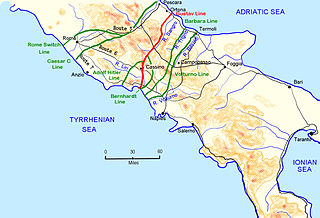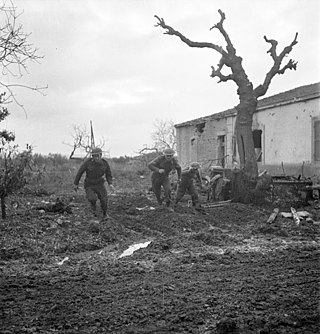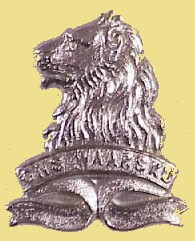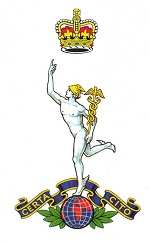
The Battle of Monte Cassino, also known as the Battle for Rome, was a series of four military assaults by the Allies against German forces in Italy during the Italian Campaign of World War II. The objective was to break through the Winter Line and facilitate an advance towards Rome.

The Battle of Anzio was a battle of the Italian Campaign of World War II that took place from January 22, 1944. The battle began with the Allied amphibious landing known as Operation Shingle, and ended on June 4, 1944 with the liberation of Rome. The operation was opposed by German and by Italian Repubblica Sociale Italiana (RSI) forces in the area of Anzio and Nettuno.

The Winter Line was a series of German and Italian military fortifications in Italy, constructed during World War II by Organisation Todt and commanded by Albert Kesselring. The series of three lines was designed to defend a western section of Italy, focused around the town of Monte Cassino, through which ran the important Highway 6 which led uninterrupted to Rome. The primary Gustav Line ran across Italy from just north of where the Garigliano River flows into the Tyrrhenian Sea in the west, through the Apennine Mountains to the mouth of the Sangro River on the Adriatic coast in the east. The two subsidiary lines, the Bernhardt Line and the Hitler Line, ran much shorter distances from the Tyrrehnian Sea to just northeast of Cassino where they would merge into the Gustav Line. Relative to the Gustav Line, the Hitler Line stood to the northwest and the Bernhardt Line to the southeast of the primary defenses.
The Battle of Cisterna took place during World War II, on 30 January–2 February 1944, near Cisterna, Italy, as part of the Battle of Anzio, part of the Italian Campaign. The battle was a clear German victory which also had repercussions on the employment of U.S. Army Rangers that went beyond the immediate tactical and strategic results of the battle.

Operation Avalanche was the codename for the Allied landings near the port of Salerno, executed on 9 September 1943, part of the Allied invasion of Italy during World War II. The Italians withdrew from the war the day before the invasion, but the Allies landed in an area defended by German troops. Planned under the name Top Hat, it was supported by the deception plan Operation Boardman.

The 2nd New Zealand Division, initially the New Zealand Division, was an infantry division of the New Zealand Military Forces during the Second World War. The division was commanded for most of its existence by Lieutenant-General Bernard C. Freyberg. It fought in Greece, Crete, the Western Desert and Italy. In the Western Desert Campaign, the division played a prominent role in the defeat of German and Italian forces in the Second Battle of El Alamein and the British Eighth Army's advance to Tunisia.

The Italian campaign of World War II, also called the Liberation of Italy following the German occupation in September 1943, consisted of Allied and Axis operations in and around Italy, from 1943 to 1945. The joint Allied Forces Headquarters (AFHQ) was operationally responsible for all Allied land forces in the Mediterranean theatre and it planned and led the invasion of Sicily in July 1943, followed in September by the invasion of the Italian mainland and the campaign in Italy until the surrender of the German Armed Forces in Italy in May 1945.

The Gothic Line was a German and Italian defensive line of the Italian Campaign of World War II. It formed Field Marshal Albert Kesselring's last major line of defence along the summits of the northern part of the Apennine Mountains during the fighting retreat of the German forces in Italy against the Allied Armies in Italy, commanded by General Sir Harold Alexander.

The 90th Light Infantry Division was a light infantry division of the German Army during World War II that served in North Africa as well as Sardinia and Italy. The division played a major role in most of the actions against the British Eighth Army in the Western Desert Campaign and eventually surrendered to the Allies in the final stages of the Tunisia Campaign in May 1943. It was re-constituted later in 1943 and deployed to Sardinia and when the expected Allied invasion of Sardinia failed to materialise, the division was moved to Italy. It was engaged in actions against the Allies in Italy from 1943 to April 1945 when the division was listed as "destroyed" in the Po River valley.

The 334th Infantry Division was a German Army infantry division in World War II. Originally formed in November 1942, it surrendered to the Allies at the conclusion of the Tunisian Campaign in May 1943. The division was reconstituted on 3 June 1943 in France within the 1st Army, with the staff of the 80th Infantry Division as well as remnants of the old division and replacement units. It spent the remainder of the war serving on the Italian Front.

The Hampshire Regiment was a line infantry regiment of the British Army, created as part of the Childers Reforms in 1881 by the amalgamation of the 37th Regiment of Foot and the 67th Regiment of Foot. The regiment existed continuously for 111 years and served in the Second Boer War, World War I and World War II. An Army Order of the 28 November 1946 stated, due to distinguished service in the Second World War, the regiment would be re-titled as the Royal Hampshire Regiment.

The Battle of San Pietro Infine was a major engagement from 8–17 December 1943, in the Italian Campaign of World War II involving Allied forces attacking from the south against heavily fortified positions of the German "Winter Line" in and around the town of San Pietro Infine, just south of Monte Cassino about halfway between Naples and Rome.

The Trasimene Line was a German defensive line during the Italian Campaign of World War II. It was sometimes known as the Albert Line. The German Commander-in-Chief (C-in-C), Generalfeldmarschall Albert Kesselring, used the line to delay the Allied northward advance in Italy in mid June 1944 to buy time to withdraw troops to the Gothic Line and finalise the preparation of its defenses.

The Moro River campaign was an important battle of the Italian campaign during the Second World War, fought between elements of the British Eighth Army and LXXVI Panzer Corps of the German 10th Army. Lasting from 4 December 1943 to 4 January 1944, the campaign occurred primarily in the vicinity of the Moro River in eastern Italy. The campaign was designed as part of an offensive launched by General Sir Harold Alexander's Allied 15th Army Group, with the intention of breaching the German Army's Winter Line defensive system and advancing to Pescara—and eventually Rome.

The spring 1945 offensive in Italy, codenamed Operation Grapeshot, was the final Allied attack during the Italian Campaign in the final stages of the Second World War. The attack in the Lombard Plain by the 15th Allied Army Group started on 6 April 1945 and ended on 2 May with the surrender of German forces in Italy.

The General de la Rey Regiment is an reserve infantry regiment of the South African Army.

The Battle of San Marino was an engagement on 17–20 September 1944 during the Italian Campaign of the Second World War, in which German Army forces occupied the neutral Republic of San Marino and were then attacked by Allied forces. It is also sometimes known as the Battle of Monte Pulito.
The 138th Brigade was an infantry brigade of the British Army that saw active service in the First World War with the 46th Division. The brigade again saw active service in the Second World War, with the 46th Infantry Division.

The City of London Signals was a Territorial Army unit of the British Army's Royal Corps of Signals. It had its origins in a signal company of the Royal Engineers formed in 1908 and during World War II it provided the divisional signals for the 56th (London) Division and its duplicates as well as communications for the Royal Air Force in the Middle East. Its successors continued in the postwar Territorial Army and Army Reserve until 2016.

The 100th Light Anti-Aircraft Regiment, Royal Artillery, was an air defence unit of the British Army during World War II. Initially raised as an infantry battalion of the Royal Fusiliers in 1940, it transferred to the Royal Artillery in 1941. It served with 56th (London) Infantry Division in the final stages of the Tunisian Campaign, in the landings at Salerno and subsequent fighting in Italy, including the Battle of Anzio, until it was disbanded at the beginning of 1945.


















